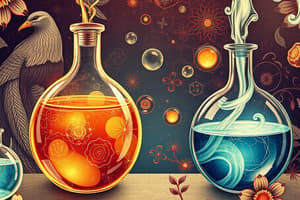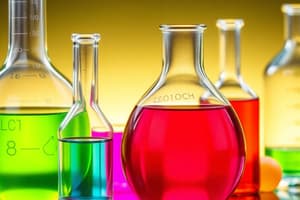Podcast
Questions and Answers
Explain the difference between reactants and products?
Explain the difference between reactants and products?
Reactants are the substances you have before the reaction occurs and the products are the new substances that are formed.
What do the arrows and coefficients used by chemists in equations communicate?
What do the arrows and coefficients used by chemists in equations communicate?
The arrows mean 'react to produce' or 'yield' and the coefficients describe the lowest whole number ratio of the amounts of all of the reactants and products.
Write the formula for nitrogen dioxide gas and designate its physical state?
Write the formula for nitrogen dioxide gas and designate its physical state?
NO₂(g)
Write the formula for liquid gallium and designate its physical state?
Write the formula for liquid gallium and designate its physical state?
Write the formula for barium chloride dissolved in water and designate its physical state?
Write the formula for barium chloride dissolved in water and designate its physical state?
Write the formula for solid ammonium carbonate and designate its physical state?
Write the formula for solid ammonium carbonate and designate its physical state?
Identify the reactants in the following reaction: When potassium is dropped into aqueous zinc nitrate, zinc and aqueous potassium nitrate form.
Identify the reactants in the following reaction: When potassium is dropped into aqueous zinc nitrate, zinc and aqueous potassium nitrate form.
When gasoline is burned in an automobile engine, what evidence indicates that a chemical change has occurred?
When gasoline is burned in an automobile engine, what evidence indicates that a chemical change has occurred?
Write the word equation for this skeleton equation: Mg(s)+FeCl₃(aq)→Fe(s)+MgCl₂(aq)
Write the word equation for this skeleton equation: Mg(s)+FeCl₃(aq)→Fe(s)+MgCl₂(aq)
Balance the equation in question 58.
Balance the equation in question 58.
What are five classes of chemical reactions?
What are five classes of chemical reactions?
How would you classify a chemical reaction between two reactants that produce one product?
How would you classify a chemical reaction between two reactants that produce one product?
Under what conditions does a precipitate form in a chemical reaction?
Under what conditions does a precipitate form in a chemical reaction?
What is a chemical reaction?
What is a chemical reaction?
Define a reactant.
Define a reactant.
Define products in a chemical equation.
Define products in a chemical equation.
What is a chemical equation?
What is a chemical equation?
What is a coefficient in a chemical equation?
What is a coefficient in a chemical equation?
What is a synthesis reaction?
What is a synthesis reaction?
What is a combustion reaction?
What is a combustion reaction?
What is a decomposition reaction?
What is a decomposition reaction?
What is a single replacement reaction?
What is a single replacement reaction?
What is a double replacement reaction?
What is a double replacement reaction?
What is a precipitate?
What is a precipitate?
Flashcards are hidden until you start studying
Study Notes
Chemical Reactions Overview
- Reactants are the initial substances before the chemical reaction; products are the new substances formed after the reaction.
- Arrows in chemical equations indicate the reaction direction, meaning "react to produce" or "yield."
- Coefficients represent the lowest whole number ratio of reactants and products in a chemical equation.
Formulas and Physical States
- Nitrogen dioxide gas is represented as NO₂(g).
- Liquid gallium is represented as Ga(l).
- Barium chloride dissolved in water is represented as BaCl₂(aq).
- Solid ammonium carbonate is represented as (NH₄)₂CO₃(s).
Identifying Reactants
- In the reaction where potassium reacts with zinc nitrate, the reactants are potassium (K(s)) and zinc nitrate (ZnNO₃(aq)).
Evidence of Chemical Change
- Indicators of a chemical change when gasoline burns include temperature change, release of heat energy, and production of carbon dioxide and water.
Skeleton Equation and Balancing
- The word equation for Mg(s) + FeCl₃(aq) → Fe(s) + MgCl₂(aq) translates to Magnesium(s) + Iron(III) Chloride(aq) → Iron(s) + Magnesium Chloride(aq).
- The balanced equation for the above reaction is 3Mg(s) + 2FeCl₃(aq) → 2Fe(s) + 3MgCl₂(aq).
Classes of Chemical Reactions
- Five major classes include:
- Synthesis reaction
- Combustion reaction
- Decomposition reaction
- Single replacement reaction
- Double replacement reaction
Classification of Reactions
- A reaction that produces one product from two reactants is classified as a synthesis reaction.
- Precipitation occurs during double replacement reactions when two aqueous solutions are mixed.
Definitions
- A chemical reaction is the rearrangement of atoms from substances to form new substances.
- Reactants are the starting substances involved in a reaction.
- Products are the resulting substances formed during the reaction.
- A chemical equation uses chemical formulas to depict the substances and their quantities in a reaction.
- A coefficient is the number that appears in front of a reactant or product in a chemical equation.
Reaction Types Defined
- Synthesis reaction: Two or more reactants combine to form a single product.
- Combustion reaction: A substance combines with oxygen, releasing heat and light.
- Decomposition reaction: A single compound breaks down into two or more products.
- Single replacement reaction: One element displaces another in a compound.
- Double replacement reaction: Involves ion exchange between two compounds.
- Precipitate: A solid that forms from a solution during a chemical reaction.
Studying That Suits You
Use AI to generate personalized quizzes and flashcards to suit your learning preferences.




